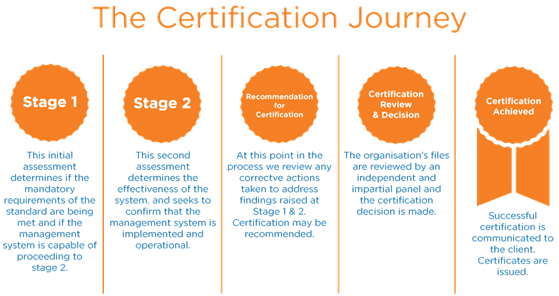ISO 45001:2018 – Safety Management System
ISO 45001:2018 is the new international voluntary standard for occupational health and safety which like OHSAS 18001 also aims at reducing unacceptable work risks and consistently enhancing the OHS performance. ISO 45001:2018 is a generic standard and can be applied to all kinds of organizations and set ups irrespective of their nature, type and size of business. It lays a set of guidelines that establish a framework by specifying requirements for your organization’s OHSMS. Aligning your organization’s OHSMS with ISO 45001:2018 can significantly mitigate risk by enhancing safety and lowering the incidents of injury and disease in workplace.
Benifits
- Reducing absenteeism and employee turnover rates
- Reducing the overall costs of incidents
- Improving organization’s ability to respond to regulatory compliance issues
- Reducing downtime and the costs of disruption to operations
- Reducing the cost of insurance premiums
- Recognition for having achieved an international benchmark (which may in turn influence customers who are concerned about their social responsibilities)
Key Features
Although ISO 45001 constitutes a fully new standard, its foundations already exist and are formulated in OHSAS 18001. Companies that have already implemented an occupational health and safety management system in accordance with OHSAS 18001, and actively apply it in everyday company practice, can therefore expect a smooth transition to ISO 45001.
Nevertheless, there are some fundamental differences, such as:
ISO 45001 implements the ‘High Level Structure’ (HLS), giving it a common framework with other management systems, such as ISO 9001 and ISO 14001.
ISO 45001 places great emphasis on the responsibility of senior management. This aspect has already been implemented in the revised ISO 9001 and ISO 14001 standards.
ISO 45001 explicitly includes persons who are not permanently employed, but are in other ways working under the responsibility of the organization/company, such as subcontractors, as well as processes that have been outsourced in their entirely.
The standard also introduces the term “opportunities”, as a new aspect in the field of occupational health and safety. This covers issues that go beyond the mere elimination or minimisation of occupational health and safety risks. ISO 45001 will provide new impetus for occupational health and safety practices in organisations. Even experienced health and safety professionals will find that the new regulations provide new incentives for further process enhancements. This translates into additional opportunities for protecting and promoting employees’ health and performance, as well as a sustainable improvement of employee motivation.
How will this impact current Occupational Health & Safety Management System certificates?
After the publication of ISO 45001:2018, the OHSAS 18001/18002 standards will be withdrawn. Organizations certified will be allotted a 3-year transition period. The steps to migrate from your current OHSAS 18001 certificate to the ISO 45001:2018 standard will follow the rules defined by the International Accreditation Forum (IAF). Depending on your current certification, transition will take one of the following routes:
- An accredited OHSAS 18001 certificate will be migrated through a seamless process to ISO 45001:2018 during the 3 years after publication as described by IAF.
- A non-accredited OHSAS 18001 certificate will follow a specific procedure which will make the transition to ISO 45001:2018 as smooth as possible.
Is it suits me?
ISO 45001:2018 can be used by any organisation, large or small, regardless of its field of activity or sector.
How’s about my Certification Journey? It’s a simple way…..

Certification to ISO 45001:2018 lasts for three years and is subject to mandatory audits to ensure that you are compliant. However, if you transition from OHSAS 18001:2007 to the ISO 45001:2018 version during your certification cycle it does not restart the three-year cycle. Deadline for organisations that are certified to the OHSAS 18001:2007 standard have until March 2021 to update to the new version of the standard.